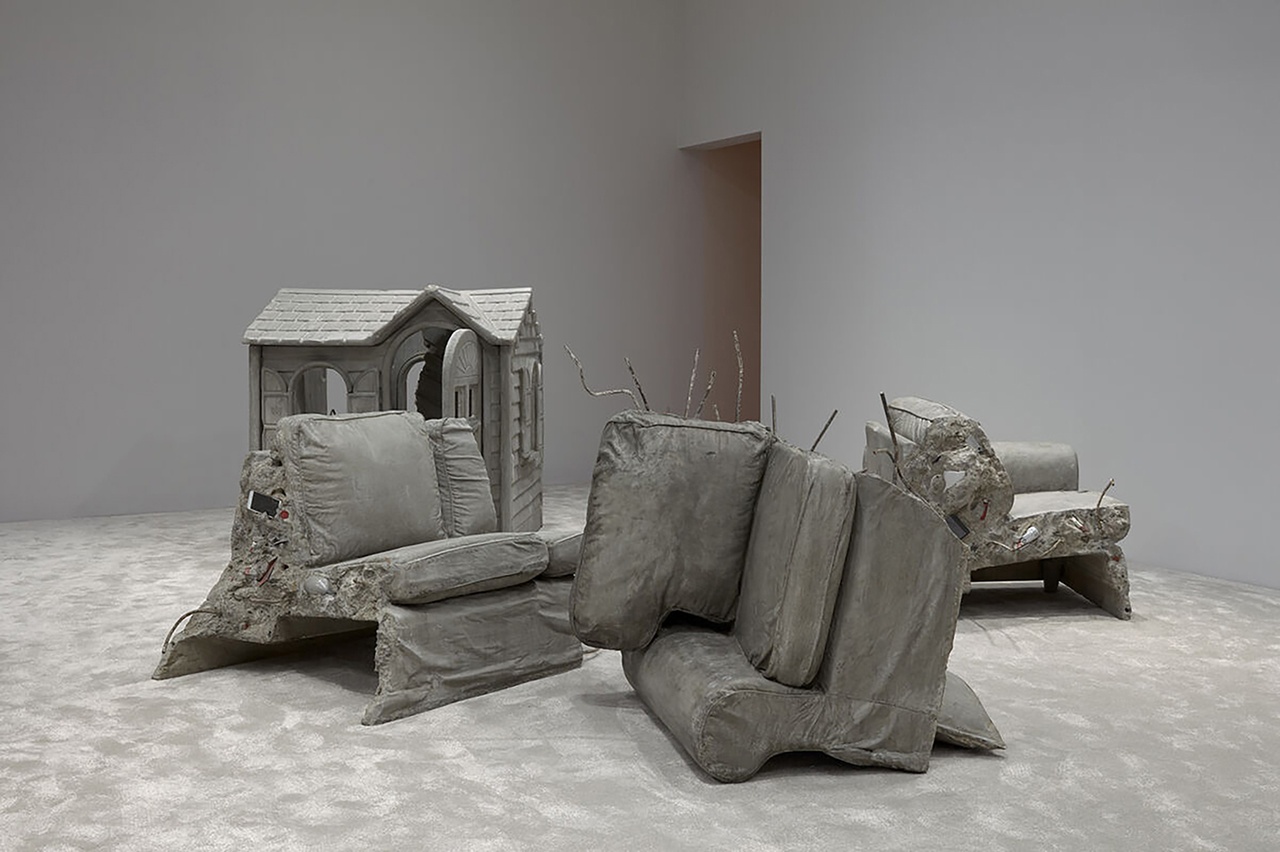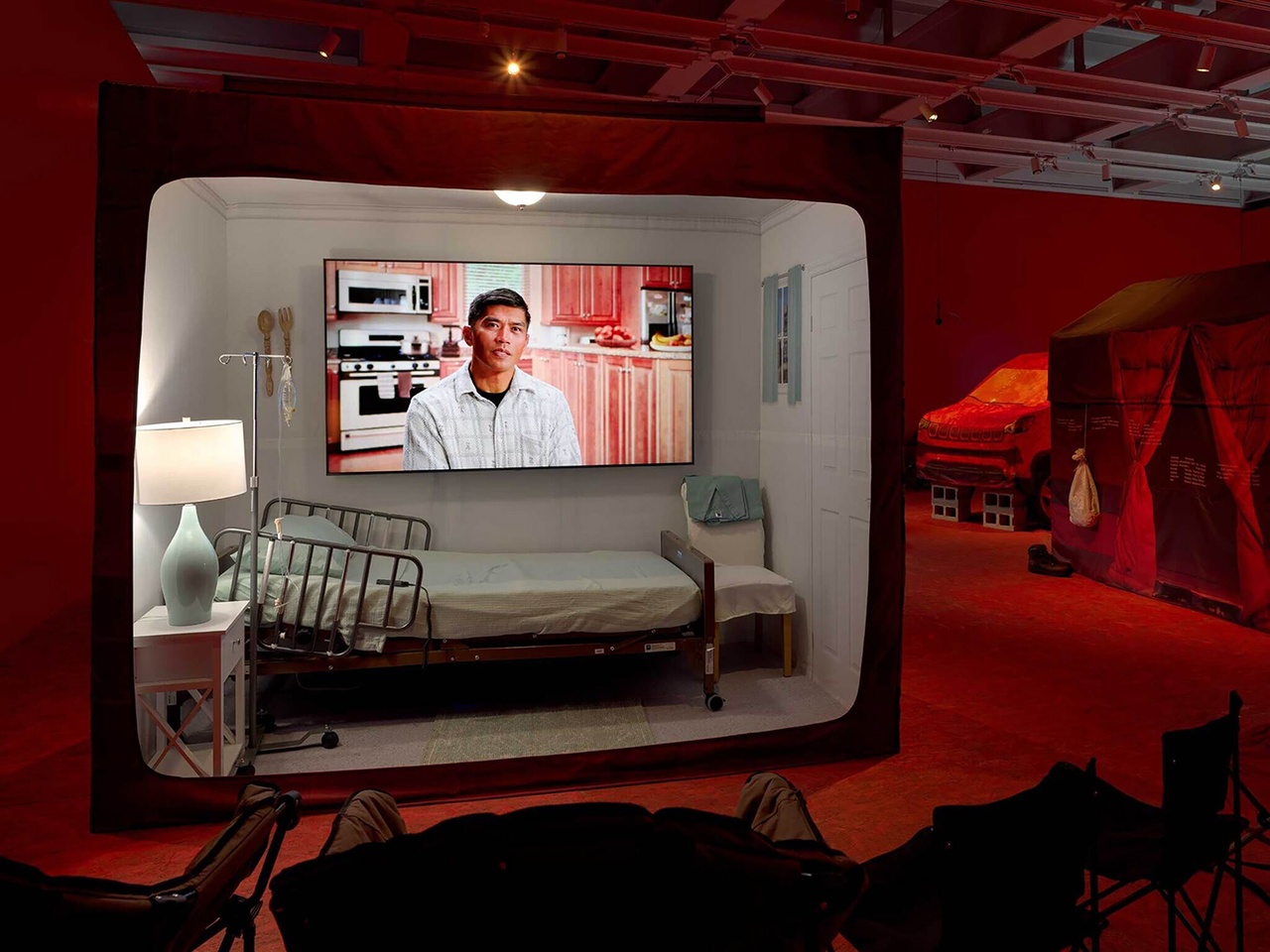LOSING FACE David Joselit on Josh Kline at the Whitney Museum of American Art, New York

“Josh Kline: Project for a New American Century,” Whitney Museum of American Art, New York, 2023, installation view
From press releases and criticism to museum catalogues and scholarly monographs, much art writing is extractivist. What these diverse genres share is the goal of excavating a unique meaning to assign to an artwork – much like minting a unit of cryptocurrency. Such a singular meaning may then circulate in the marketplace of ideas as a marker of value, not unlike an auction price. What art critics do is thus indirectly in service to the market: we’re producing currency, quanta of meaning that can fix an ineffable artwork as a fungible product. Just because we’re underpaid doesn’t mean we don’t have our role in the smooth operation of art commerce – or what is now called the “art industry.” Why else would David Zwirner have a publishing house, Hauser & Wirth a magazine, and Gagosian a vanity publication so glossy in its luscious reproductions and advertisements that you can smell it off-gassing for days after you pop it out of its plastic sleeve?
Extractivist art writing may be common, but it’s hardly inevitable. The solution is straightforward, which is not to say easy to perform: one must try to maintain the conviction that art is not translatable (into text), that form produces multiple (even infinite) meanings rather than represents a unique one. To press my extractivist metaphor too far, think of all the waste byproducts generated through mining. We need to build our own resistance to art fracking – to ravaging ecologies of form in order to capture a valuable refined substance, the “liquid gold” of art’s profitable meaningfulness.
The subject of this review is Josh Kline’s exhibition at the Whitney Museum, “Project for a New American Century.” Like many savvy artists, Kline has provided the perfect prompt for an extractivist reading in the title of his show. Here is how such an analysis might go: In contrast to what is conventionally known as “the American century” – the 20th, in which the US consolidated a military and commercial empire – Kline imagines a post-apocalyptic version of American decline in the 21st century that is alternately rendered as a form of civil war and a utopian vision of anodyne diversity. The former of these options is embodied in several works including a series of sculptures of devastated domestic furnishings (my favorite is a collapsed plastic children’s playhouse) transposed into lumpen grey fossils composed of polymerized gypsum and other additives, larded with little bits of trash as though the American suburbs had suffered the same fate as Pompeii. An opposing optimistic option for envisioning a New American Century is embodied in the three-channel video installation Another America Is Possible (2017), in which a multiethnic and intergenerational group of beautiful and beatific Americans have a picnic while burning the Confederate flag. This is what’s called critique (which is the “progressive” term for extracting a singular meaning), and no less a legitimately radical figure than Laura Poitras confirms it in an interview with Kline published in the exhibition catalogue. She declares: “But I also think there is a way in which your work makes the art world and cultural institutions confront themselves.” [1] If “confrontation” is a euphemism for the narcissistic satisfaction of believing that the “art industry” is not actually an industry, then Poitras has hit the nail on the head.
But there is no reason we must fall into the trap that the exhibition title sets for us. Instead of identifying a dominant or singular meaning that can be expressed with the concision of a press release or wall label, I want to discuss a formal operation, or format, that functions across several of Kline’s works, evoking a diverse array of affective responses. In other words, instead of ventriloquizing what Kline says, I want to suggest the rules of his formal grammar. This review is consequently not an overview, but rather a judgment (the traditional but now nearly defunct role of the critic) based on the productivity of Kline’s forms rather than their meaning.

“Josh Kline: Project for a New American Century,” Whitney Museum of American Art, New York, 2023, installation view
In my opinion what is most interesting in Kline’s work, what makes his show a genuine philosophical/affective proposition about a “New American Century,” is what I’ll call the rhetoric of “losing face,” which encompasses at least three distinct formats, often in combination: “face swapping,” amputation, and “talking heads.” In various works of the mid-2010s, Kline used a then-new digital technique known as face swapping to project the likenesses of celebrities (or others) onto the heads of actors in order to animate historical figures (or others) in contradictory ways. In Crying Games (2015), for instance, hawkish public figures of the 2000s –Condoleezza Rice, Tony Blair, Donald Rumsfeld, George W. Bush, and Dick Cheney – are made to tearfully confess their misgivings about the disastrous war in Iraq that they promoted. Rice’s insincere simpering is particularly excruciating. In another series of video works, deceased celebrities Kurt Cobain and Whitney Houston sit for posthumous interviews, thereby artificially extending their lives beyond their premature deaths. The uncanny effect of these uses of early face-swapping software arises not only from their rendering of impossible actions, but also from glitches that allow the digital mask to interpenetrate the pixels of an actual actor’s representation in a literal embodiment of a two-faced figure – one who is deceitful, insincere. Losing face here is a form of losing control of oneself, whereas the amputations Kline performs in a second genre of “losing face” have an even more sinister cast. These occur for instance as the heads of blue-collar workers are 3D printed and tossed into shopping carts, utility trolleys, or shipping cartons in a literalization of the metaphor of “severance” of employment. Sometimes, though, these faces are also swapped, as when a FedEx mailing label tattoos the printed head of a worker in the 2014 work No Sick Days (FedEx Worker’s Head with FedEx Cap), giving that amputee a second skin. Finally, the third format of “losing face” is the interview – conducted by talking heads – which Kline has explored consistently over his career. It occurs in the most recent series in the exhibition, Personal Responsibility (2023–ongoing), as part of his Climate Change project. Included within sculptures evoking various forms of temporary shelter is a series of videotapes, each focusing on a single fictional figure recounting their complicated reaction to a future society coping with climate disaster. A central theme in these monologues is a recounting of the degree of responsibility professed by each character for their own survival and that of others. While the heads here are not literally severed from their bodies, it is solely the face, the mouth, the discourse, the talking head, that gives an account of the self. And in Personal Responsibility these narrations of individual responses to a fictionalized (though plausible) post-disaster scenario range from despairing to self-righteous. A chorus of survivors each tells their own “truth” so that the talking head becomes a figure for the severance of the individual from the social body through privatization – a political form of amputation.
Losing face is undoubtedly a significant subjective experience for citizens of a waning empire, and thus it is an apt figure for a “New American Century.” But the multiple dimensions of this condition explored by Kline – encompassing operations of swapping, severing, and narration of self – as well as their constitutive instability (i.e., the very loss of face is often experienced as being two-faced) make this exhibition more than a one-liner. In Kline’s rendering, losing face encompasses a spectrum of affective experience ranging from humiliation to self-assertion (the face speaks even if swapped or amputated), which is the kind of toxic combination that produces 21st-century American neo-fascism and its standard-bearer Donald Trump – the epitome of a bellicose victim claiming humiliation as political capital. But instead of packaging the equation I’ve insinuated between losing face and losing empire as a slogan of critique, I propose that we simply allow ourselves to experience the complex and contradictory emotions it generates. In other words, let’s drink up this volatile cocktail of rage and mourning and face up to its queasy intoxication before rushing to take action in its name.
“Josh Kline: Project for a New American Century,” Whitney Museum of American Art, New York, April 19–August 13, 2023.
David Joselit is the Arthur Kingsley Porter Professor and Chair of Art, Film, and Visual Studies at Harvard University. His most recent book is Art’s Properties (Princeton University Press, 2023).
Image credit: © Josh Kline, courtesy of Josh Kline and Modern Art, London, photos Robert Glowacki
Note
| [1] | “Extinction Story and Other Possibilities: A Conversation between Josh Kline and Laura Poitras,” in Josh Kline: Project for a New Century, exh. cat., ed. Christopher Y. Lew (New York: Whitney Museum of American Art; New Haven, CT: Yale University Press, 2023), 200. |
